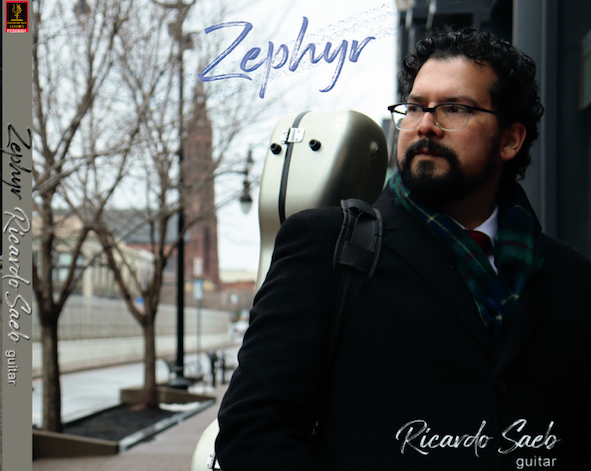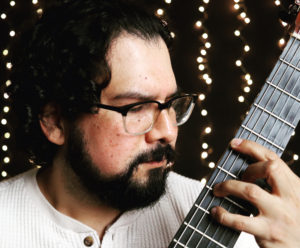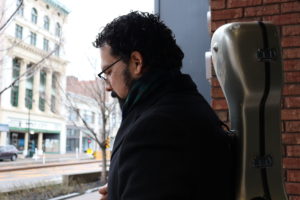
In a word: delightful! Ricardo Saeb is a Mexican guitarist whose name is new to me. There are innumerable CDs of solo guitar music, and a reasonably good percentage of those that have come my way have been enjoyable. Even with that as a baseline, I find this one exceptional.
First, Saeb has chosen his program wisely. There is great variety in the music, and intelligent planning in the sequence in which they appear. Saeb moves from one composer’s style to another in order to ensure a sense of freshness as you listen. After beginning with an arrangement of a Mexican folk song, “La llorona,” with its strong earthy rhythms, he goes to an exquisitely gentle piece, Un sueño en la floresta (A Dream in the Forest), by Agustin Barrios Mangoré. Its mood recalls one of the most famous works in the guitar literature, Francesco Tárrega’s Recuerdos de la Alhambra, with its lilting lyricism. This is followed by Dionisio Aguado’s La Fandango, an early work from 1835, which Saeb plays with great clarity and a firm rhythmic pulse.
The most modern-sounding work here is the two-movement Elogio de la danza by Cuban composer Leo Brouwer, originally composed for a ballet. The harmonies are spikier than the rest of the program, and the rhythms not quite as predictable. The work has been recorded before, but it is new to me, and I would find it hard to imagine a more secure or persuasive reading.
Astor Piazzolla’s somber La muerte del ángel (The Death of the Angel) played in an arrangement for guitar by Brouwer, is one of those gorgeous tangos the Argentine composer wrote not for dancing or singing, but for appreciative listening, indeed for listening closely. Saeb does not shortchange the darkness that is at the root of the piece. Through dynamic shadings and his reaction to harmonic change, Saeb tastefully and effectively underlines it.
Saeb’s strong rhythmic pulse makes for a vivid reading of Joaquín Turina’s Sevillana, while his delicate sense of shading emphasizes the almost Impressionistic colors of the work that gives this CD its title, Zephyr by the American composer Christopher Gainey. The longest work on the disc is Joaquín Rodrigo’s Sonata giocosa. It makes a perfect conclusion, because the three movements bring together all of Saeb’s strengths of sharp rhythmic vitality, fine ear for color and dynamics, and lovely legato.
The notes, presumably by Saeb, are very informative, and the recording quality is superb. This is one of the most enjoyable guitar CDs I’ve encountered in a long time.
FANFARE: Henry Fogel
***************************************************************************
Beginning with a perfectly calibrated folksong from his home country La llorona (The Weeping Woman), Mexican guitarist Ricardo Saeb offers up what he sees as a “playlist.” A very modern concept, then, providing holding space, and flow, for much older music. The very idea found me catching myself listening subtly differently, almost second-guessing what was “up” next. As it happens, the folksong seems to enjoy a spiritual kinship with Agustin Barrios Mangoré’s astonishing Un sueñio en la floresta (A Dream in the Forest), in which the guitar seems to cut itself into two layers of different timbres for melody and accompaniment; it is balanced later in the program by Barrios Mangoré’s Choro de Saudade, full of melancholic rhythm, brilliantly realized here by Saeb.
Although listed on the back cover simply as Le Fandango, Dionisio Aguado’s piece is a set of variations (elsewhere the title is given as Le Fandango varié). It is also known as Fandango variado. It is a delightful piece, musically imaginative and played with supreme understanding by Saeb.
It is quite a stretch to move from Aguado (1784–1849) to Leo Brouwer (b. 1939); but what a treat it is to hear Elogio de la danza. I enjoyed this piece enormously on Lou Marinoff’s Phoenix disc Classical Journey (see my interview From Bach to Buddhism via Table Hockey in Fanfare 40:1). Context is key here, as I find it impossible to find a preference between the two; both performers are at the top of their game, both relish the challenges. It is a rather nice touch to feature a Brouwer arrangement of Piazzolla, too: La muerte del ángel, a piece originally used for the stage in the tale of an angel who heals broken Argentinian souls, and who dies in a knife fight.
The sheer energy of Turina’s Sevillana is remarkable and acts as something of a staging post in the disc’s program; it is a piece that has previously been recorded by the likes of Segovia, but Saeb makes it all his own with a beautifully sweet touch. It contrasts with the gentle piece that gives this disc its name, Zephyr, by Christopher Gainey (b. 1981), its metric play giving it a sort of gentle sway. It is heard here in its world premiere recording, and it is joined by another short piece by a living composer, Gerardo Taméz’s Platerias, a beautifully restrained piece grounded in Mexican folklore.
It is about time we had a fine recording of Rodrigo’s Sonata giocosa, and here is the main reason to celebrate this release. This was Rodrigo’s first guitar sonata and, as the name implies, is an absolute delight, not least in the way he plays with and subverts formal and harmonic expectations. It only lasts 11 or 12 minutes in toto, but Saeb persuades us it is a perfectly manicured gem.
This is a lovely recital. It is Saeb’s first recording on the Fleur de Son label; one already looks forward to his second.
FANFARE: Colin Clarke
***************************************************************************
For Ricardo Saeb, Zephyr’s program is “in essence a playlist of some of my favorite guitar pieces.” Here, Classical, Romantic, and contemporary music sit agreeably side by side in sophisticated, beautiful performances sure to please anyone who shares Saeb’s love of the guitar. The Classical world is represented by Dionisio Aguado’s Le Fandango, an entertaining mix of 18th-century melodic and harmonic common practice and flamenco tropes—sharply articulated runs, rolled chords, tremolos, broken octave passages, and a gradually accelerating conclusion—that coalesces in the dance episodes that give it its name. Also very much in flamenco mode is Turina’s Sevillana (Fantasia), with its dramatic, vigorous strumming (rasgueados), alternating major and minor runs, passionate blend of tempestuous and lyrical expression, parallel chords and triplet passages. La llorona (The Weeping Woman) is a very popular Mexican folk song, heard here in Julio Cesar Oliva’s sensitive arrangement. Saeb’s flexible rubato endows the “beautifully sad melody” with memorable expressiveness: For him it’s both a nod to his heritage and a touching tribute “to those loved ones that supported me through the years but are no longer here with us.” Rather than come to a definite conclusion, it fades evocatively away, the haunting imagery lingering in the air.
Paraguayan Agustin Barrios Mangoré is represented by two pieces, Un sueno en la floresta (A Dream in the Forest) and Choro de Saudade. To his biographer, Richard Stover (Six Silver Moonbeams: The Life and Times of Agustin Barrios Mangoré), “Barrios was basically composing Romantic-era music years after the fact [he died in 1944]. But he was also blending other influences, like Latin American music in its popular forms.” And guitarist Berta Rojas, an indefatigable champion of the composer, believes that “you feel the very soul of Latin America in his music.” Each of Un sueño’s several sections has its charms, with the lovely tremolo passages being perhaps the most moving. Un sueño is actually one half of an artistic creation, as it’s the score, if you like, to “a fantastic tale of Barrios,” a poetic legend about the origins of the guitar (the liner notes reproduce a slightly different translation):
Tupa, the supreme spirit and protector of my people,
Found me one day in the middle of a greening forest,
Enraptured in the contemplation of Nature,
And he told me: “Take this mysterious box and reveal its secrets.”
And enclosing within it all the songs of the birds of the jungle
And the mournful signs of the plants,
He abandoned it in my hands.
I took it and obeying Tupa’s command I held it close to my heart.
Embracing it I passed many moons on the edge of a spring fountain
And one night, Yacy (the moon, our mother),
Reflected in the crystal liquid,
Feeling the sadness of my Indian soul,
Gave me six silver moonbeams
With which to discover its secrets.
And the miracle took Place:
From the bottom of the mysterious box,
There came forth a marvelous symphony
Of all the virgin voices of America.
Choro—a “cry” or “lament”—is a popular Brazilian genre born in the late 1800s that’s thought of as “the grandfather of bossa nova, the father of samba” (Pedro Ramos of the Choro Ensemble). Although inherently melancholy, it can also have “a fast and happy rhythm,” as in Choro de Saudade’s livelier syncopated sections or Villa-Lobos’s Choro No. 1. (For an even more exuberant multi-instrument sample, listen to NPR’s podcast Choro Ensemble: Brazil Before Bossa(npr.org/templates/story/story.php?storyId=88102556.)
Gerardo Tamez’s “compositional style is deeply rooted in Mexican folkloric musical elements” (Saeb) but his Platerias (Homenaje a Taxco) is more gentle abstraction than outright mimicry. The framing sections follow a stop-and-start pattern, as if dancers were periodically “frozen” before moving again. Those slight hesitancies allow the ringing last notes of each phrase to linger, imparting, if I’m not being too fanciful, a silvery radiance wholly in keeping with the title’s literal meaning of “silversmithing.” The delicate harmonics periodically adorning both the introductory figures and the heartfelt central melody, along with ascending series of muted pizzicatos, are ethereally evocative touches.
Leo Brouwer is one of Cuba’s best-known guitarist/composers, famous not only for his many works for his chosen instrument but for his varied catalog that includes some 30 film scores, most famously Like Water for Chocolate. His music often reflects his Afro-Cuban heritage but reconfigured with startling originality, frequently in an “advanced” harmonic language, atonal at times but highly accessible. Elogio de la danza, commissioned by choreographer Luis Trápaga for a ballet, is in two movements. The first, Lento, is spare, initially meditative, as one might expect from an elegy but spiced with incisive recitative, colorfully dissonant chords and a faster, strongly rhythmic episode prefiguring the second movement “Obstinato,” in which the “obstinacy” is amplified by intense flamenco rasguedos and percussive accents—guitar body taps—all set within what Saeb calls “the elaborate atonal soundscape.”
Although I’m not sure, I believe that Astor Piazzolla’s La muerte del ángel was originally composed for bandoneón, piano, violin, guitar, and double bass (the makeup of his quintet), so guitarists everywhere are in Leo Brouwer’s debt for this arrangement in which Piazzolla’s characteristic fusion of exciting, up-tempo “hooks” and meltingly sweet melodies captivates from beginning to end. Christopher Gainey’s Zephyr, although unequivocally contemporary, nonetheless, at least to my ears, seems faintly haunted by ghosts of the Spanish Renaissance—a phrase here, a pattern of movement or counterpoint there. I can’t be more specific without seeing a score, but the subtle Spanish flavor, transcending any particular period, ensures that it’s an ideal disc mate for the rest of Saeb’s program. Turning to Joaquín Rodrigo, the first and third movements of his Sonata giocosa exude the same happy, folk-dance-like exuberance as the outer movements of his famous Concerto de Aranjuez; the puckish slides in the concluding Allegro are an especially amusing touch. The Andante moderato, a Baroque Sarabande in all but name, preserves the idiomatic gravitas of the form (periodically lightened by major-key iterations of the initially minor-key material), and serves as a contemplative midpoint between the two extroverted Allegros.
To conclude, I’m confident that this debut recital will appeal to a wide variety of collectors. I’m impressed throughout by Ricardo Saeb’s persuasive musicality, technical mastery, and stylistic flexibility. His interpretations, always expressive and without a trace of artifice, should immediately “connect” to a receptive audience. Recommended.
FANFARE: Robert Schulslaper

